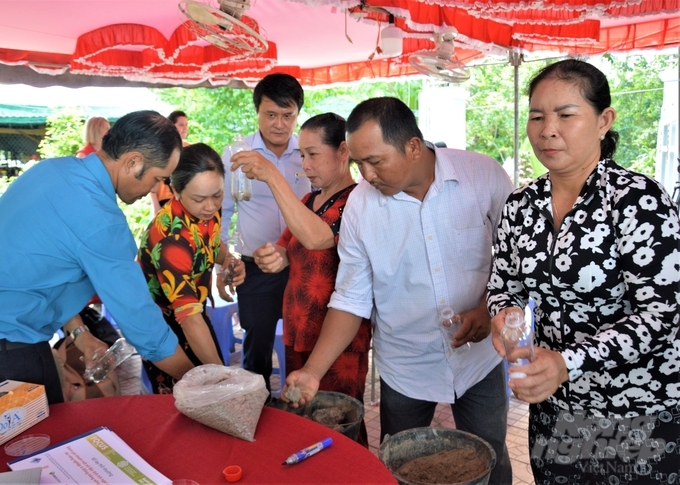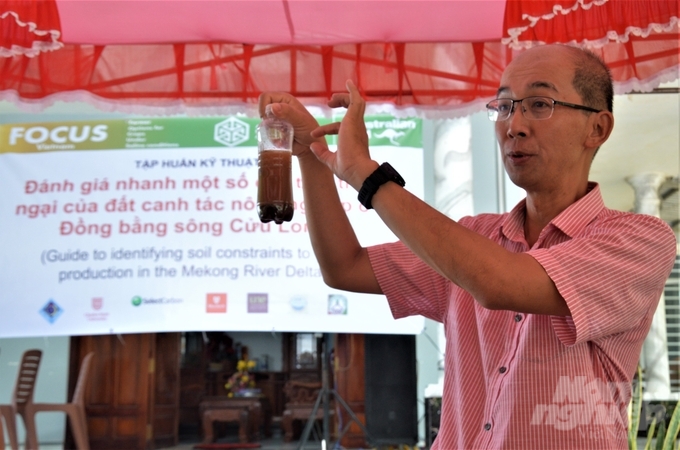farmers as soil scientists
The work from taking soil samples, classifying, numbering, filling test tubes, analyzing, recording data… is meticulously done by the farmers themselves.
For the first time, dozens of farmers in Vinh Vien A Township (Long My District, Hau Giang Province) were “scientists” to analyze the soil, so they were very excited. You will be guided and supported by staff from the Department of Soil Science at the Faculty of Agriculture (Can Tho University) and experts from Australia.

Farmers “scientists” first conducted their own experiments to study the soil for agricultural production. Picture: Trung Chanh.
Ms. Vo Thi Kim Loan and her husband, Mr. Tieu Van Vu, have more than 2 hectares of land where they can cultivate three paddy fields annually. Intensive farming continuously increases crops, rice production is high, but income is falling due to rising costs. Seeing this, Ms. Loan and Mr. Vu changed part of the area (four people) to take turns planting vegetables and rice. Ms. Loan said that to grow watermelons on rice land, people would have to hire people to dig trenches and mulch. After two melon harvests, they planted again to cover the rice crop. Therefore, both rice and melon are more profitable than specialized cultivation.
According to Ms. Loan, in continuous rice or vegetable production, given the slow growth of the crop and the assumption that the soil is degraded and depleted of nutrients, farmers will increase fertilization but are unaware of the specific nutrient deficiency. What.
“Now that I’ve been analyzed by the trainers, I know that the floor is made up of many components. Then the soil is contaminated with alum, the salinity also causes the plants to wither and become slow. Dung is just useless and even makes the tree die faster,” says Ms. Loan shared the knowledge she learned.
Simple experiments
As part of the activities of the project “Diversity of crop plants on rice soils under saline conditions in the Mekong Delta” (FOCUS project) under the direction of Assoc.Prof.Dr. Chau Minh Khoi is the chair, the project team from the Faculty of Soil Science – School of Agriculture (Can Tho University) and experts from Australia will organize professional training in the places where the project will be implemented.
The aim of the training course is for the project implementation team to guide and equip local agricultural staff and farmers with some knowledge and skills related to how to quickly assess some of the impeding characteristics of agricultural land.

associate Prof. Dr. Chau Minh Khoi guides farmers to conduct simple experiments to analyze soil and quickly assess some of the difficult characteristics of agricultural land. Picture: Trung Chanh.
associate Prof. Dr. Chau Minh Khoi and his colleagues directly guided farmers to collect each soil sample for testing. When the soil is thrown into the water, air bubbles form as the soil dissolves. Oxygen escapes from the holes in the ground. Holes in the ground have the task of storing oxygen and water and thus promoting the growth of plant roots. When the soil is callous (the soil is compacted), it becomes difficult for plants to grow.
dr Susan Orgill, a soil science expert from Australia, instructed farmers to place soil samples in a bottle of water to soak them, then shake them to dissolve and settle them, analyzing: “The structure of soil has many components, the heaviest Layer that sinks at the bottom of the bottle is sand, followed by soil, suspended and floating matter is organic matter. Organic matter plays a role in binding soil and providing nutrients for plant growth.
Using a soil sampling device from the top layer to a depth of 1 m, the farmers observed that each soil layer has different colors. Testing the acidity (measuring pH) of the soil at each location will give different results because the salinity in the soil will give different results.
associate Prof. Dr. Chau Minh Khoi explained: “The soil in the Mekong Delta is formed by the accumulation of sea sand and alluvium over a long formation process. Sediments, remains of animals, plants and vegetation at the surface decompose and accumulate over the years to form soil, so the soil layers have different colors.

